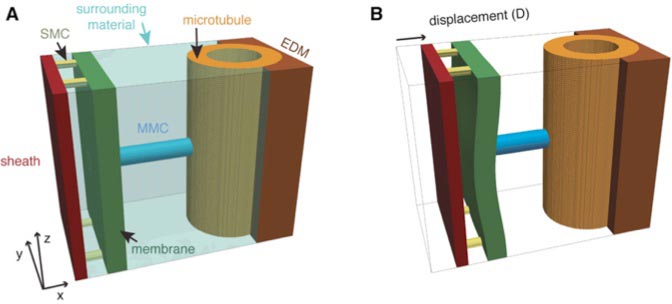Axel Voigt Group
Mathematical Modeling and Numerical Simulation of Cells and Systems

© Katrin Boes
Besides experimental measurements and visualizations, mathematical modeling provides a third approach to discover and understand biological systems. We concentrate on cells as their basic entities and model and simulate their mechanical behavior as an individual or within an ensemble. To consider living cells to models are combined with biomolecular network signaling. Our ultimate goal is the quantitative simulation of biological systems with predictive power.
Cell mechanics
Mechanical properties of cells determine the physical limits of cell function. We explore these properties in continuum mathematical models to describe cell deformations according to external forces. In cooperation with the experimental research group of J. Guck this can be used to characterize cells according to physiological changes. Combining the mechanical models with signaling networks and reaction-diffusion mechanisms allows to model cell motility. The crawling of eukaryotic cells was e.g. considered in W. Marth, A. Voigt: Signaling networks and cell motility: a computational approach using a phase field description. J. Math. Biol. DOI 10.1007/s00285-013-0704-4
Cytoplasmic streaming
Cytoplasmic streaming refers to the fluid-like motion of the cytoplasm of cells. It is driven by the motion of the motor protein myosin along filamentary actin strands. The resulting flow patterns can today be experimentally visualized. However various questions remain, e.g. What determines the velocity? How is the flow pattern regulated? What is the nature of the molecular transport controlled by cytoplasmic streaming? We analyze these questions using the tools of computational fluid dynamics and validate our simulation results agains experimental measurements e.g. of the research group of S. Grill.
Coarsening dynamics of domains in lipid membranes
Domains appear after a rapid temperature quench, when the membrane is cooled through a miscibility phase transition such that coexisting liquid phases form. In membranes quenched far from a miscibility critical point, circular domains nucleate and then progress within seconds to late stage coarsening in which domains grow via two mechanisms collision and coalescence of liquid domains, and Ostwald ripening. We model these phenomena and compute statistical data, such as as growth exponents and size distribution functions. Of primary interest is the influence of surface viscosity, geometry modulations and membrane bound proteins. Publication: T. Witkowski, R. Backofen, A. Voigt: The influence of membrane bound proteins on phase separation and coarsening in cell membranes. Phys. Chem. Chem. Phys., 14 (2012) 14509

Future Projects and Goals
We continue to investigate cell mechanics to understand their individual and collective behavior. Both mathematical and biological/biophysical projects are available.
We will increasingly work on tissue models, considering mechanical interactions of epithelia cells, quantitative cytoplasmic streaming simulations and simulation and cell resolved simulations of morphogenesis. PhD projects typically combine mathematical modeling, high performance computing and experimental validation. We are also involved in the development of the massively parallel simulation software AMDiS, which is based on adaptive finite elements.
Methodological and Technical Expertise
- Continuum modeling using partial differential equations
- Massively parallel adaptive finite element simulations
- Image processing analysis
- 3D print technology